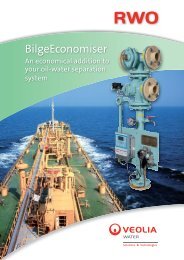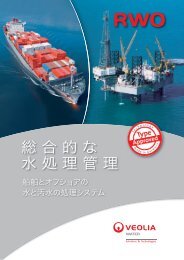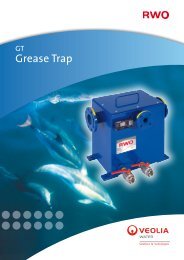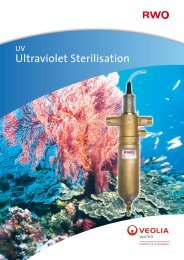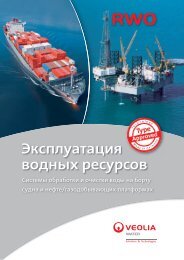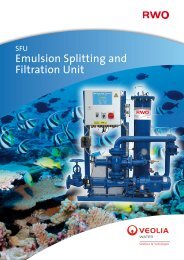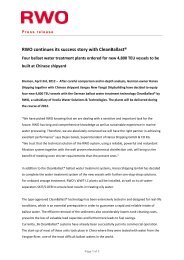the IHS Ballast Water Guide - RWO Marine Water Technology
the IHS Ballast Water Guide - RWO Marine Water Technology
the IHS Ballast Water Guide - RWO Marine Water Technology
You also want an ePaper? Increase the reach of your titles
YUMPU automatically turns print PDFs into web optimized ePapers that Google loves.
<strong>IHS</strong> Fairplay Solutions <strong>Guide</strong> to <strong>Ballast</strong> <strong>Water</strong> Treatment Systems Sponsored by<br />
Practicalities<br />
With so many systems ei<strong>the</strong>r fully<br />
approved or expected to be approved<br />
shortly, <strong>the</strong>re is increasing pressure for<br />
<strong>the</strong> mandatory installation programme<br />
to begin without fur<strong>the</strong>r delay. There are<br />
likely to be benefi ts for operators willing<br />
to consider installation ahead of any<br />
mandatory deadlines, as <strong>the</strong>re could be a<br />
price advantage if manufacturers offer<br />
incentives for early orders to recoup<br />
some of <strong>the</strong>ir R&D costs. Ano<strong>the</strong>r factor<br />
is <strong>the</strong> ability of shipyards to<br />
accommodate <strong>the</strong> rush to install<br />
equipment when <strong>the</strong> retrofi t deadlines hit.<br />
The choice of supplier is something that<br />
will need careful consideration bearing in<br />
mind that <strong>the</strong> system chosen is likely to<br />
be in use throughout <strong>the</strong> working life of<br />
<strong>the</strong> ship. The sheer number of ships that<br />
will come under <strong>the</strong> BWM Convention will<br />
include tens of thousands of existing vessels<br />
needing retrofi ts.<br />
However, once this bonanza has passed,<br />
manufacturers will only have <strong>the</strong> spares<br />
and service aftermarket and an average of<br />
around a thousand new ships per year to<br />
provide an income. The newbuilding market<br />
from 2016 onward is surely not suffi cient<br />
to support all of <strong>the</strong> systems now on <strong>the</strong><br />
market or being developed.<br />
When contemplating <strong>the</strong> implementation<br />
of a BWTS an operator needs to look at<br />
various practicalities – primarily that <strong>the</strong><br />
system will guarantee full compliance with<br />
<strong>the</strong> BWM Convention (once fully ratifi ed)<br />
and also that it will fi t within <strong>the</strong> space<br />
available on board.<br />
A lot of companies have employed <strong>the</strong><br />
ideas learned from experience in wastewater<br />
treatment systems.<br />
An eff ective system should also both<br />
reduce <strong>the</strong> energy needed to haul sediment<br />
build-up and increase <strong>the</strong> ship’s cargocarrying<br />
capacity.<br />
The design of <strong>the</strong> ballast system pipe<br />
layout needs to be borne in mind, as well.<br />
Some systems make use of components<br />
that can be placed at various locations<br />
around <strong>the</strong> ship. For those systems that use<br />
active substances to treat micro-organisms,<br />
suffi cient stocks of those substances will<br />
have to be carried on board to satisfy <strong>the</strong><br />
number of units installed and <strong>the</strong> frequency<br />
and quantity of ballast operations.<br />
Many systems use <strong>the</strong> eff ect of UV on<br />
water, or <strong>the</strong> properties of seawater to react<br />
to electric currents, to generate <strong>the</strong> active<br />
substance on board, which means that<br />
<strong>the</strong>re is no need to hold stocks of an active<br />
substance on board.<br />
Ano<strong>the</strong>r important aspect is <strong>the</strong> low<br />
operating pressure of an ultraviolet<br />
disinfection system, which saves costs in<br />
retrofi ts by allowing existing pumps to be<br />
employed and <strong>the</strong>reby often eliminating <strong>the</strong><br />
need for reconstruction.<br />
Maintenance and inspections are essential<br />
for all systems. Abrasive sediment must not<br />
be allowed to build up and aff ect ballast tank<br />
coatings. Lamps and fi lters will need to be<br />
replaced and some form of pre-fi ltration is<br />
often desirable.<br />
Closely linked to maintenance is <strong>the</strong> level<br />
of training needed to ensure <strong>the</strong> system is<br />
operated correctly. Although most systems<br />
feature a high level of automation, o<strong>the</strong>rs<br />
will require more manual intervention<br />
especially if active substances are involved.<br />
40 © <strong>IHS</strong> Global Limited 2012<br />
040_041_BW1204.indd 40 21/03/2012 18:47:14



